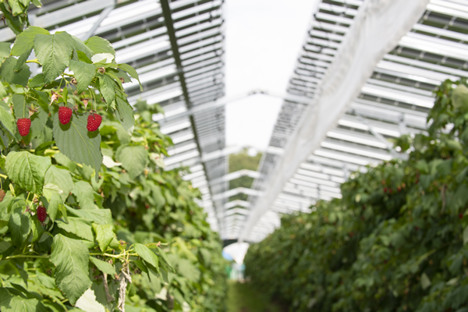GroenLeven has started constructing Europe’s largest softfruit covering agri-PV project. When this unique project is complete, Dutch grower Maarten van Hoof, who cultivates raspberries, blackberries, currants, and asparagus, will have 24,206 solar panels protecting his raspberries. These panels will generate enough green power for about 2,810 households, HortiDaily informs.
Agri-PV is a wonderful example of the multifunctional use of space. Fruit is grown, and solar energy is generated on the same plot of land. The sturdy solar panel installation protects the crops from all weather conditions. Since plastic sheeting is commonly used, these panels are sustainable, too. The installation also provides a stable climate, which benefits fruit growth. GroenLeven has completed several agri-PV projects in the Netherlands that together account for nearly 15 megawatts.
A pilot project preceded the building of this large agri-PV project. In 2020, Maarten installed solar panels above some of his raspberries and blackberries. After successful results, the grower chose to install these panels over his entire raspberry crop.
“We usually cover the fruit with plastic to protect it from severe weather conditions,” Maarten begins. “Raspberries can’t stand too much rain; they go moldy. And these panels are sturdier; I don’t have to worry when there’s a big storm. They also don’t rattle when there’s a lot of wind, don’t reflect the sun, and are more labor-friendly. You have to replace foil often. I think it looks better, too. It’s an investment that future-proofs my business.”
GroenLeven has completed several of these projects, including above raspberries, currants, and strawberries. Says Bram Wasser, GroenLeven agri-PV project manager: “Agri-PV offers many advantages for growers. Each fruit variety requires a different use of agri-PV.”
“Together with Wageningen University & Research (WUR), we investigated the best application of agri-PV for each known Dutch fruit variety. The studies considered, for example, the panels’ light transmission (PAR), the climate under them, temperature, crop protection product reduction, fruit production, and Brix levels.”
“The Netherlands is a small country with various spatial challenges,” CEO Peter Paul Weeda adds. “Think of the energy transition and housing shortage. GroenLeven has, from the start, specialized in the multifunctional use of space with solar panels. Large solar roofs, solar carports, solar panels at an airport, and, by now, more than half a million GroenLeven solar panels floating on sand extraction ponds. That makes the Netherlands a leader in Europe and outside of China.”
“Agri-PV is a great example of the multifunctional use of space. Without additional government support, it’s unfortunately impossible to further roll out these projects in the Netherlands. It costs more to realize agri-PV than a standard solar farm. We’re therefore in talks with authorities to find suitable solutions. This chance at energy transition shouldn’t be lost,” says Paul.
Maarten is pleased with his agri-PV system. “Fellow growers, who are also considering these kinds of panels, often phone me,” he says. Sustainability is deeply rooted in Maarten and his company, and he is proud of that. “With this project, I can say I grow the most sustainable raspberries and blackberries in the Netherlands,” he concludes.
The use of the site materials is free if there is a direct and open for search engines hyperlink to a specific publication of the East-Fruit.com website.




